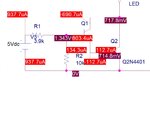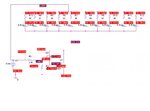kdg007
Full Member level 3
oh :O G_current is Icbo ? Rb = ( Vcc - 2*Vf ) / ( Ic / G_current + 2*Vf / R3 ),with this we dont have to bother keeping R3 right  ?
?
-
hmm... so,do u suggest not keeping r3? Icbo wouldnt effect much ?
-
also,we dont have to lower R3 much ..as long as it drives 0.1μAdc current across it.. 1k to 3k ohm resistance should do i guess!!
-
hmm... so,do u suggest not keeping r3? Icbo wouldnt effect much ?
-
also,we dont have to lower R3 much ..as long as it drives 0.1μAdc current across it.. 1k to 3k ohm resistance should do i guess!!
Last edited:


